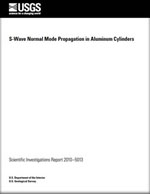Large amplitude waveform features have been identified in pulse-transmission shear-wave measurements through cylinders that are long relative to the acoustic wavelength. The arrival times and amplitudes of these features do not follow the predicted behavior of well-known bar waves, but instead they appear to propagate with group velocities that increase as the waveform feature's dominant frequency increases. To identify these anomalous features, the wave equation is solved in a cylindrical coordinate system using an infinitely long cylinder with a free surface boundary condition. The solution indicates that large amplitude normal-mode propagations exist. Using the high-frequency approximation of the Bessel function, an approximate dispersion relation is derived. The predicted amplitude and group velocities using the approximate dispersion relation qualitatively agree with measured values at high frequencies, but the exact dispersion relation should be used to analyze normal modes for full ranges of frequency of interest, particularly at lower frequencies.


